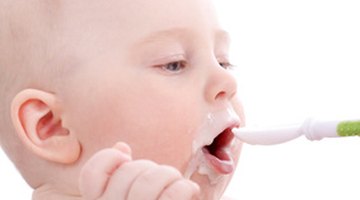When Do Babies Stop Formula?
Making the Switch From Formula
Formula fulfills all your baby's nutritional needs for the first several months of life. Gradually, he starts to explore the world of solids, but formula still plays a major role in your baby's diet. Knowing when to make the big switch ensures your little one gets all the nutrition he needs without missing out on key vitamins, minerals and fat, all of which are essential for his development.
When Do Babies Stop Eating Formula?

How to Teach a Baby to Swallow Food
Learn More
Babies need the nutrients in formula or breast milk for the first year of life. Even after you start solid foods, you should continue offering your baby formula until she reaches 12 months. Your baby doesn't need any other drinks during this time. Juice adds sugar to your child's diet and may fill her up, so she won't eat the more nutritious options on her plate. Babies who eat solids can have some water if they don't always want formula with meals.
Moving to Solid Food
Somewhere around age 4 to 6 months, many babies develop the ability to eat solid foods. You'll know your little one is ready when he shows the following signs:
- He's almost doubled his birth weight
- Interest in food
- Ability to hold his head up well
- Sitting without assistance
- Motor skills to push food to the throat instead of pushing it out of the mouth
The first solids your baby eats are only small amounts to help him learn how to eat foods like cereal and pureed items. His formula still provides most of his nutrition. Most babies start with just a small amount of iron-fortified cereal mixed with formula after a regular bottle-feeding session. A thin consistency makes it easier for your baby to learn how to eat something other than formula.
Once your little one masters cereal, start adding single-ingredient baby foods. Wait two or three days before trying something new, so you can easily identify the cause if your baby develops symptoms of an allergic reaction. The formula should still be the primary nutritional source, but it's important to continue offering a variety of foods to give him a balanced diet by the time he quits formula.
Switching to Cow's Milk

How to Transition From Formula to Milk
Learn More
Babies can safely switch to whole cow's milk at age 1, but it's important that your child has the habit of eating solids well-established. Let her eat a variety of different kinds of solid food. Instead of getting most of her nutrients from milk, now she gets the things her body needs from solid food. Too much cow's milk fills up her tummy and keeps her from eating the food she needs.
Some babies resist the change from formula to cow's milk. Make the transition easier by mixing a little milk with her normal formula. Gradually mix it with more milk and less formula until the switch is complete.
It's important to serve your baby whole milk instead of skim or low-fat milk from age 1 to age 2. She needs the fat in the whole milk for proper brain development. At age 2, talk to her pediatrician about switching to 2 percent or 1 percent milk.
Dealing With Milk Allergies
The transition to cow's milk can come with some speed bumps if your little one is allergic or lactose-intolerant. If your baby drinks soy-based formula, talk to your pediatrician before trying cow's milk. Even if your baby drinks regular formula made from cow's milk, you should watch for signs of allergic reactions when you start him on cow's milk.
Those signs include:
- Itchiness, swelling or watery eyes
- Wheezing or trouble breathing
- Coughing
- Hoarseness
- Upset stomach, vomiting or diarrhea
- Hives or red spots
- Swelling
If you notice any symptoms after your baby drinks cow's milk, call your pediatrician. Seek medical attention immediately if your baby has difficulty breathing.











